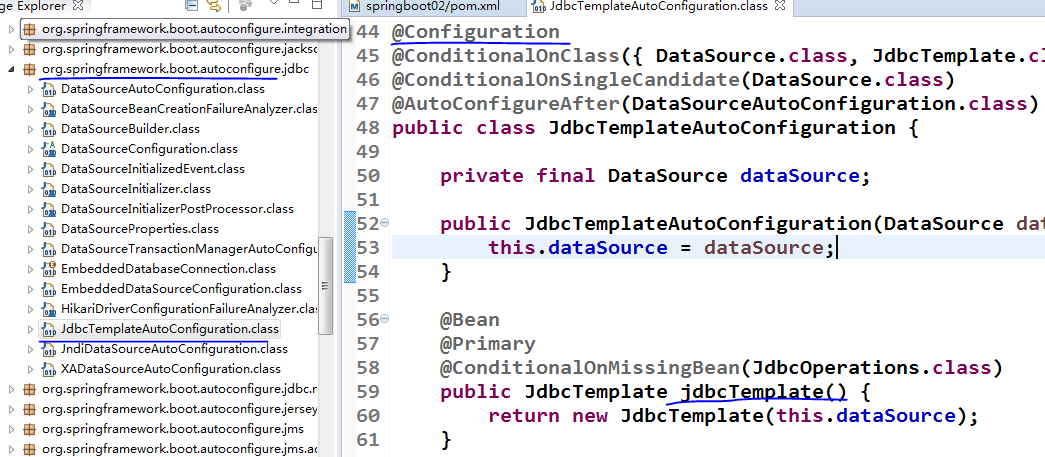一 JdbcTemplate的使用
Spring对数据库的操作在jdbc上面做了深层次的封装,使用spring的注入功能,可以把DataSource注册到JdbcTemplate之中。 JdbcTemplate 是在JDBC API基础上提供了更抽象的封装,并提供了基于方法注解的事务管理能力。 通过使用SpringBoot自动配置功能并代替我们自动配置beans. 在maven中,我们需要增加spring-boot-starter-jdbc模块
<!-- jdbcTemplate 以及事务支持-->
<dependency>
<groupId>org.springframework.boot</groupId>
<artifactId>spring-boot-starter-jdbc</artifactId>
</dependency>点开spring boot的自动配置包spring-boot-autoconfigure-1.5.2.RELEASE.jar,找到如下所示代码
发现spring boot已经自动帮我们初始化好了jdbcTemplate对象,并且默认采用tomcat数据源dataSource,当然我们提供的数据源,系统将采用我们自定义的数据源!
完整的pom文件如下所示:
<project xmlns="http://maven.apache.org/POM/4.0.0" xmlns:xsi="http://www.w3.org/2001/XMLSchema-instance"
xsi:schemaLocation="http://maven.apache.org/POM/4.0.0 http://maven.apache.org/xsd/maven-4.0.0.xsd">
<modelVersion>4.0.0</modelVersion>
<groupId>com.wx</groupId>
<artifactId>springboot02</artifactId>
<version>0.0.1-SNAPSHOT</version>
<parent>
<groupId>org.springframework.boot</groupId>
<artifactId>spring-boot-starter-parent</artifactId>
<version>1.5.2.RELEASE</version>
</parent>
<dependencies>
<dependency>
<groupId>org.springframework.boot</groupId>
<artifactId>spring-boot-starter-web</artifactId>
</dependency>
<!-- jdbcTemplate 以及事务支持-->
<dependency>
<groupId>org.springframework.boot</groupId>
<artifactId>spring-boot-starter-jdbc</artifactId>
</dependency>
<!-- MySQL连接 -->
<dependency>
<groupId>mysql</groupId>
<artifactId>mysql-connector-java</artifactId>
<scope>runtime</scope>
</dependency>
<dependency>
<groupId>org.apache.tomcat.embed</groupId>
<artifactId>tomcat-embed-jasper</artifactId>
<scope>provided</scope>
</dependency>
<!-- jstl标签库 -->
<dependency>
<groupId>jstl</groupId>
<artifactId>jstl</artifactId>
<version>1.2</version>
</dependency>
<!-- 阿里巴巴json解析包 -->
<dependency>
<groupId>com.alibaba</groupId>
<artifactId>fastjson</artifactId>
<version>1.1.15</version>
</dependency>
<!-- 阿里巴巴druid连接池 -->
<dependency>
<groupId>com.alibaba</groupId>
<artifactId>druid</artifactId>
<version>1.0.9</version>
</dependency>
</dependencies>
<build>
<finalName>${project.artifactId}</finalName>









 最低0.47元/天 解锁文章
最低0.47元/天 解锁文章
















 434
434

 被折叠的 条评论
为什么被折叠?
被折叠的 条评论
为什么被折叠?










